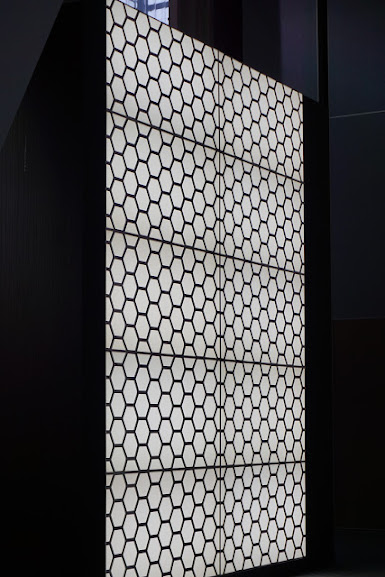WHY IN DESIGN COLUMN: Loving the Aesthetic Movement & Learning About This Slice of History in Design
Smithsonian's Freer Gallery of Art
Jefferson Drive and 12th St., SW
Washington, DC
Peacock Room, Gallery 12
1880 quote by designer William Morris,
"If you want a golden rule that will fit everybody, this is it: have nothing in your houses that you do not know to be useful or believe to be beautiful."
Let's Talk About the Aesthetic Movement
With Modern-Day Views
of the Peacock Room!
A Dining Room, Once Had Three Homes- Since 1923, The Peacock Room has been at the Freer Gallery of Art at the Smithsonian in Washington DC. It was first created by artist James McNeill Whistler who then displayed a gorgeous Chinese porcelain collection in this beautiful space in a private London mansion of Frederick Leyland. In 1892, the entire room was up for sale when the owner of the Freer museum, Charles Lang Freer bought it to showcase his own private collection of ceramics, and had the dining room installed then in his Detroit home. Today, the room is on display at the Smithsonian Museum which shows beautiful florals & birds, and in a gorgeous deep tiffany-blue coloring, and inspired by East Asian decorative arts and design. The gallery offers a virtual tour for those who cannot see it in person, and the story takes visitors through the journey from the room's three homes. Modern-day artist/painter Darren Waterston re-created Whistler's famed Peacock Room, which many claim is a window into the then popular Aesthetic Movement and acts as a American art masterpiece. It was falling apart (literally) when Waterston restored it to its new splendor.
all about the renovation here. the ceramics from various timeframes had to be stored during the renovation. The blue and white ceramics had to be thoroughly cleaned and cared for after years of being displayed.
What is the Aesthetic Movement?From 1860 to 1900's The Aesthetic Movement was surging in Britain- this particular style of design and art was a movement to overturn the ugly designs stemming from the Industrial Revolution. Instead of materialism, the idea was to create beautiful, decorative design channeling nature. The thought leaders of the Movement felt deep meaning was no longer necessary in art and design as beauty was the sole focus of the Aesthetic Movement. Their mantra being to create beauty and created the term, 'Art for Art's sake'. The results were some of the most beautiful, timeless designs in history. The Movement single-handedly transformed the British middle class home, then influenced the rest of the world. William Morris, Edward Burne-Jones, James McNeill Whistler and others were leaders in the Aesthetic Movement.
One of the first to lay down the groundwork for this philosophy (although he refused to take credit) of the Movement was writer, philosopher and art critic, John Ruskin, who influenced William Morris who later lead to the many core beliefs in both the Aesthetic Movement as well as the Arts and Crafts Movement (which followed the Aesthetic Movement from 1880 to 1920).
Ruskin's writings criticized the effects of the industrialization showing the degradation of art and craftsmanship during the Victorian era. Some of these ideas were spelled out in his writings, "The Stones of Venice", and "the Seven Lamps of Architecture" where he emphasized the importance of preserving traditional craftsmanship and the beauty in nature.
In 1890, writer Oscar Wilde wrote,
"Beauty has as many meanings as man has moods. Beauty is the symbol of symbols. Beauty reveals everything, because is expresses nothing. When it shows itself, it shows us the whole fiery-coloured world."
According to the V&A museum in London,
"Today Aestheticism is acknowledged for its revolutionary renegotiation of the relationships between the artist and society, between art and ethics, and between the fine and decorative arts, all of which prepared the way for the arts movements of the 20th century."
Happy Nesting,
XO Tamara















